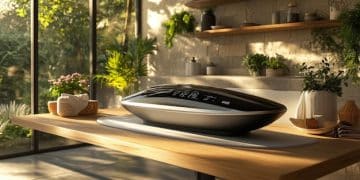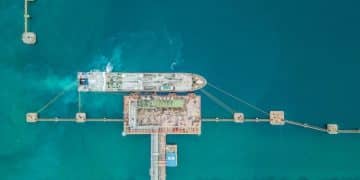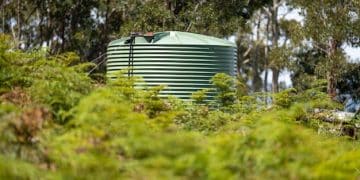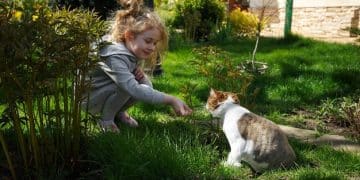Water Conservation Tips: Reduce Your Usage by 15% at Home
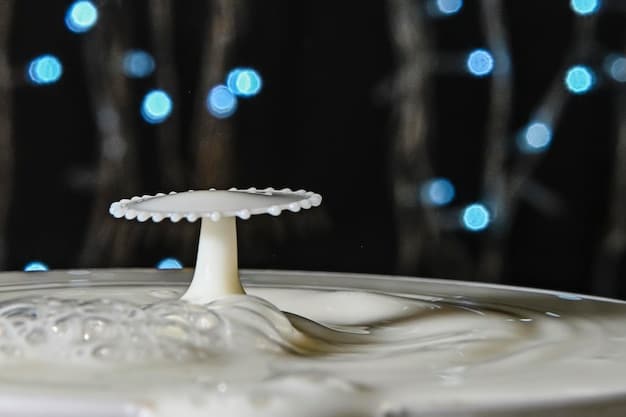
Effective water conservation in homes can significantly reduce water usage by 15% or more, contributing to lower utility bills and environmental sustainability through simple, strategic improvements and behavioral changes.
In an era where every drop counts, understanding and implementing effective water conservation tips: reduce your water usage by 15% with these simple home improvements is not just an environmental imperative but a smart financial move. Reducing water consumption by a significant margin, such as 15%, is an achievable goal that benefits both your wallet and the planet, ensuring a sustainable future for vital resources.
Understanding Your Water Footprint at Home
Before diving into specific improvements, it’s crucial to grasp where your household water goes. Most people are often surprised to learn that a significant portion of their daily water consumption isn’t from obvious sources like showering or washing dishes, but from subtle, often overlooked areas.
Understanding your water footprint involves differentiating between direct and indirect water use. Direct use includes all the water you physically use, such as for bathing, cooking, and landscaping. Indirect use, on the other hand, refers to the water consumed in the production of goods and services you use, from the food you eat to the clothes you wear. However, for the purpose of home conservation, our focus remains primarily on direct usage within the household.
Common Areas of High Water Usage
Identifying the main culprits of water waste is the first step towards effective conservation. Bathrooms, kitchens, and outdoor landscaping typically account for the largest shares of residential water use. Each of these areas presents unique opportunities for significant reductions in consumption.
- Toilets: Older models can use up to 7 gallons per flush, making them one of the biggest water consumers indoors.
- Showers and Baths: Long showers and full baths can quickly deplete considerable amounts of water.
- Laundry: Washing machines, especially older, inefficient models, can use tens of gallons per load.
- Irrigation: Lawns and gardens often consume more water than necessary due to inefficient irrigation systems or overwatering.
By pinpointing these high-usage areas, homeowners can prioritize improvements that will yield the most impactful savings. It’s not about drastic changes overnight, but rather a series of informed decisions that collectively lead to a substantial reduction in your overall water footprint.
Moreover, leak detection plays a critical role here. A single leaky faucet can waste hundreds of gallons a month, while a running toilet can be an even greater culprit, often going unnoticed. Regular checks for leaks are simple, yet profoundly effective measures in stopping unnecessary water loss.
Quick Fixes for Immediate Water Savings
Achieving a 15% reduction in water usage doesn’t always require extensive renovations. Many simple, often inexpensive adjustments can be made immediately, offering instant savings on your water bill. These quick fixes are an excellent starting point for any household looking to become more water-efficient.
One of the easiest and most impactful changes is installing low-flow fixtures. These devices are designed to use significantly less water while maintaining adequate pressure and performance. They are surprisingly effective and can be installed by most homeowners without professional help.
Installing Low-Flow Aerators and Showerheads
Aerators are small devices that can be screwed onto most faucets, mixing air into the water stream to reduce flow while maintaining pressure. Low-flow showerheads, similarly, restrict the flow of water without compromising your shower experience. These are relatively inexpensive upgrades with a rapid return on investment.
- Faucet Aerators: Reduce flow to 0.5–1.5 gallons per minute (GPM) compared to standard 2.2 GPM.
- Low-Flow Showerheads: Limit flow to 1.5–2.0 GPM, saving thousands of gallons annually.
- Dishwasher and Washing Machine Settings: Utilize eco-friendly or short cycle options when available.
Beyond fixture upgrades, simple behavioral changes are equally, if not more, important. Turning off the tap while brushing teeth or shaving, taking shorter showers, and only running dishwashers and washing machines when they are full are habits that quickly add up to substantial savings.
Consider also collecting rainwater for outdoor use. A simple rain barrel can capture hundreds of gallons of water during a single downpour, which can then be used to water plants, wash cars, or clean outdoor surfaces, reducing dependence on municipal water for non-potable uses.
Even small leaks can lead to significant water waste over time. Regularly check faucets, toilets, and pipes for any signs of leaks. Fixing a running toilet, for instance, can prevent the loss of hundreds, if not thousands, of gallons of water per month. These immediate steps pave the way for more comprehensive long-term strategies.
High-Impact Home Improvements for Long-Term Savings
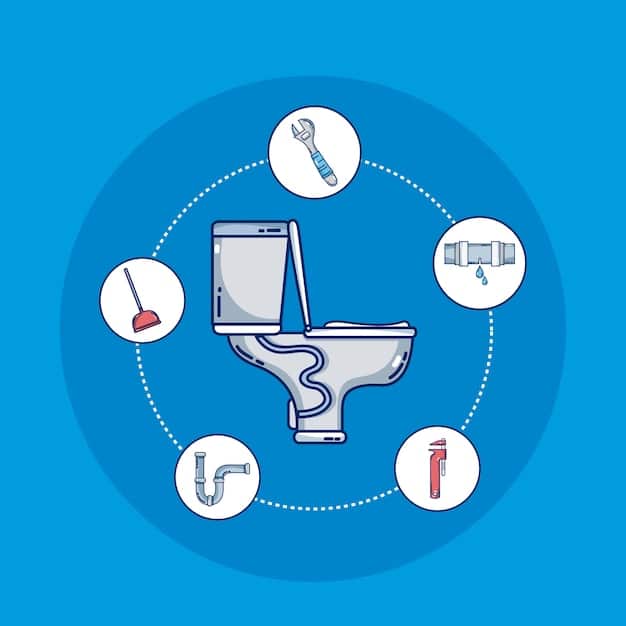
Once you’ve implemented the quick fixes, consider more significant home improvements that offer substantial, long-term water savings. These investments often have a higher upfront cost but provide excellent returns over time, far exceeding the initial 15% reduction goal.
Upgrading to water-efficient appliances is one of the most effective ways to lower your household’s water consumption. Modern appliances are designed with advanced technology to minimize water use without compromising performance. Look for products with the WaterSense label from the EPA, which indicates high efficiency.
Upgrading to High-Efficiency Appliances and Fixtures
Replacing old, inefficient toilets with dual-flush or low-flow models is a prime example. These toilets use significantly less water per flush, leading to impressive savings over their lifespan. Similarly, investing in a high-efficiency washing machine or dishwasher can dramatically reduce water use in the laundry room and kitchen.
- Dual-Flush Toilets: Offer two flushing options – one for liquid waste (0.8 gallons) and one for solid waste (1.6 gallons).
- High-Efficiency Washing Machines: Use up to 50% less water than traditional models, often due to front-loading designs.
- Smart Irrigation Systems: Utilize weather data and soil moisture sensors to water lawns and gardens only when necessary.
Another area for high-impact improvement is your irrigation system. Traditional sprinkler systems can often overwater, leading to runoff and wasted water. Smart irrigation controllers, on the other hand, use local weather forecasts, soil moisture sensors, and plant-specific needs to optimize watering schedules, ensuring your landscape receives just the right amount of water.
For those considering a more extensive renovation, converting to xeriscaping or drought-tolerant landscaping can virtually eliminate the need for extensive irrigation. This involves using native plants, gravel, and mulch that thrive in arid conditions, drastically reducing outdoor water consumption.
While these improvements might seem a larger undertaking, the cumulative water savings and benefits to the environment are substantial. They represent a commitment to sustainable living that goes beyond simple behavioral changes, embedding water efficiency into the very fabric of your home.
Outdoor Water Conservation Strategies
Outdoor water usage, particularly for landscaping, can account for a substantial portion of a household’s total consumption, especially in warmer climates. Implementing smart outdoor conservation strategies is vital for achieving significant reductions beyond indoor efforts.
The key to efficient outdoor watering lies in understanding your landscape’s specific needs and optimizing your irrigation practices. Many people tend to overwater, leading to runoff and wasted resources, as well as potentially harming plants by creating an environment conducive to root rot.
Smart Landscaping and Irrigation Techniques
One of the most impactful strategies is to re-evaluate your lawn and garden design. Shifting towards drought-tolerant plants, native species, and groundcovers that require less water is called xeriscaping. This design approach can drastically cut down on irrigation needs.
- Xeriscaping: Design landscaping to reduce or eliminate the need for irrigation.
- Mulching: Apply a layer of mulch around plants to retain soil moisture and reduce evaporation.
- Drip Irrigation: Delivers water directly to the plant roots, minimizing evaporation and runoff.
Beyond plant selection, the method of irrigation is critical. Traditional sprinkler systems often lose a significant amount of water to evaporation and wind drift. Drip irrigation systems, on the other hand, deliver water slowly and directly to the plant roots, maximizing absorption and minimizing waste.
Consider the timing of your watering. Watering in the early morning or late evening reduces evaporation losses. Avoid watering during the hottest part of the day, when much of the water will simply evaporate before it can penetrate the soil.
Rainwater harvesting is another excellent outdoor conservation method. Installing rain barrels or a more extensive rainwater collection system allows you to capture and store precipitation for later use on your garden, car washing, or other outdoor needs, further reducing your reliance on municipal water. Regular lawn maintenance, such as proper mowing height, can also help your lawn retain moisture more effectively.
Leveraging Technology for Water Efficiency
The advancements in smart home technology offer exciting new avenues for water conservation. These innovations move beyond simple adjustments, providing precise control, real-time monitoring, and automated systems that can elevate your water efficiency efforts.
Smart home devices can help you identify sources of waste, optimize usage, and even detect leaks before they become major problems. Integrating these technologies can transform your home into a truly water-smart environment, automating much of the conservation process.
Smart Home Devices and Water Monitoring
One of the most popular applications of smart technology in water conservation is the smart irrigation controller. These devices connect to local weather stations and soil moisture sensors to determine the optimal watering schedule for your landscape. They can adjust watering times based on rainfall, humidity, and temperature, ensuring your plants receive just what they need, no more, no less.
- Mainline Shut-Off Valves: Can remotely shut off water supply in case of a burst pipe or major leak.
- Water Leak Detectors: Place them near appliances like washing machines or water heaters to get immediate alerts for leaks.
- Smart Shower Meters: Monitor your water usage during showers, providing real-time feedback to help shorten shower times.
Beyond irrigation, smart leak detectors can provide invaluable peace of mind. Placed strategically near water heaters, washing machines, or under sinks, these sensors can detect even small leaks and send immediate alerts to your smartphone, potentially saving you from significant water damage and waste.
Some advanced systems even offer whole-home water monitoring, providing detailed insights into your family’s water consumption patterns. By analyzing this data, you can identify areas where you’re using the most water and pinpoint opportunities for further savings. These systems can track flow rates and even flag unusual usage patterns that might indicate a hidden leak.
The beauty of leveraging technology is its ability to provide both convenience and precision. It takes the guesswork out of water management and empowers homeowners to make data-driven decisions about their consumption. While there’s an initial investment, the long-term savings and environmental benefits make these technologies a worthwhile consideration for any eco-conscious homeowner.
Regular Maintenance and Leak Detection
Even with the most efficient fixtures and smart technologies in place, regular maintenance and proactive leak detection remain paramount to effective water conservation. Small, unaddressed leaks can silently waste thousands of gallons of water annually, literally draining your efforts and budget.
Think of leak detection as regular health checks for your plumbing system. Just as you maintain your car or your own health, consistent vigilance over your home’s water infrastructure is crucial for preventing unforeseen water waste and costly repairs down the line.
Simple Steps to Identify and Address Leaks
One of the easiest ways to check for leaks is by monitoring your water meter. Choose a period when no water is being used in your home (e.g., overnight) and record the meter reading. Check it again after a few hours; if the reading has changed, you likely have a leak somewhere.
- Toilet Leak Test: Add a few drops of food coloring to your toilet tank. If color appears in the bowl after 15-20 minutes without flushing, you have a silent leak.
- Outdoor Faucet Check: Inspect outdoor spigots and garden hoses for drips and tight seals.
- Pipe Inspection: Periodically check visible pipes under sinks and in basements for any signs of moisture or corrosion.
Beyond obvious drips, some leaks are notoriously subtle. Running toilets, for instance, are common culprits of unseen water waste. The food coloring test described above is a simple yet effective method for detecting these silent water thieves.
Routine maintenance extends beyond just fixing leaks. It includes checking the integrity of your outdoor irrigation system, ensuring sprinkler heads are not broken or misaligned, and that drip lines are functioning correctly. Keeping gutters clean and downspouts clear can also prevent water from pooling near your home’s foundation, which can lead to other issues.
Addressing these issues promptly can prevent not only water waste but also potential property damage. A proactive approach to plumbing maintenance is a fundamental pillar of any comprehensive water conservation strategy, ensuring that every drop serves its intended purpose.
Educating Your Household and Community
Achieving significant water savings and sustaining them requires a collective effort, starting within your own household and extending into your community. Water conservation is not just about individual actions; it’s about fostering a culture of awareness and responsibility.
Education is the cornerstone of this collective endeavor. When every member of the household understands the value of water and the impact of their choices, conservation becomes a shared goal rather than a series of isolated tasks. This understanding can then ripple outwards, influencing broader community practices.
Fostering a Culture of Water Conservation
Start by making water conservation a regular topic of discussion at home. Explain why you’re making specific changes, whether it’s upgrading to a low-flow showerhead or collecting rainwater. Involve children in activities like leak detection or mindful watering of plants to instill good habits early on.
- Lead by Example: Demonstrate water-saving habits in your daily routine.
- Engage Children: Turn conservation into a game or a family project.
- Share Knowledge: Discuss best practices with neighbors and community members.
Beyond your immediate family, extending your conservation efforts to the community can amplify impact. Participate in local water conservation initiatives, share your experiences and successes, and encourage others to adopt water-smart practices. Many communities offer rebates or incentives for water-efficient upgrades, which can be great conversation starters.
Supporting local policies that promote water efficiency, such as tiered water rates that encourage less usage, or regulations on landscape irrigation, can also lead to broader systemic change. Community gardens that use drought-tolerant plants or integrate rainwater harvesting systems serve as living examples of sustainable practices.
Ultimately, a widespread commitment to water conservation emerges from informed and engaged individuals. By educating your household and participating in community efforts, you contribute to a larger movement that recognizes water as a precious, finite resource, ensuring its availability for future generations.
| Key Point | Brief Description |
|---|---|
| 💧 Low-Flow Fixtures | Install aerators and low-flow showerheads for instant water savings. |
| 🏡 Appliance Upgrades | Invest in WaterSense-certified toilets, washers, and dishwashers. |
| 🌳 Smart Landscaping | Opt for xeriscaping, mulch, and drip irrigation to reduce outdoor water use. |
| 💡 Tech Integration | Utilize smart leak detectors and irrigation controllers for automated efficiency. |
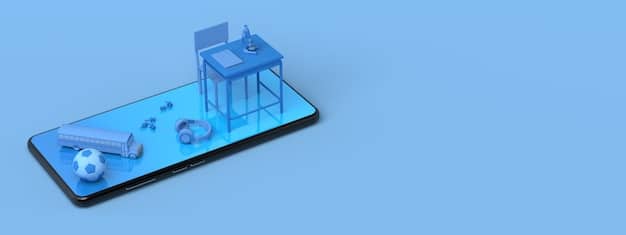
Frequently Asked Questions About Water Conservation
▼
You can see immediate results, especially from behavioral changes like shorter showers. Installing low-flow fixtures can show significant savings on your next water bill. High-impact improvements like new appliances might take a few billing cycles to reflect their full benefit, but the overall trend will be downward.
▼
Many water-saving devices, like faucet aerators and low-flow showerheads, are quite affordable and easy to install yourself. Larger investments, such as high-efficiency toilets or washing machines, have a higher upfront cost but often qualify for local rebates and provide substantial long-term savings that offset the initial expense.
▼
Modern low-flow fixtures are designed to deliver satisfactory water pressure by incorporating air into the flow or using advanced spray patterns. While they use less water, the perceived pressure often remains strong, ensuring a comfortable experience for showering and washing, debunking common misconceptions about reduced performance.
▼
Involve them in the process! Explain the benefits, like lower bills and helping the environment. Make it a game to see who can take the shortest shower or find a dripping faucet. Lead by example and celebrate small victories to create a shared commitment to water-saving habits within the household.
▼
A simple and effective method is the dye test. Put a few drops of food coloring into your toilet tank. Wait about 15-20 minutes without flushing. If any color appears in the toilet bowl, you have a leak, likely from a faulty flapper valve that needs to be replaced. It’s a quick and easy way to identify hidden waste.
Conclusion
Embracing water conservation within your home is a journey of continuous improvement, yielding profound benefits for your household budget and the environment. By implementing a combination of simple behavioral shifts, smart fixture upgrades, strategic home improvements, and leveraging modern technology, achieving and even exceeding the goal of a 15% reduction in water usage is entirely within reach. Every thoughtful action, from fixing a leaky faucet to optimizing your landscape, contributes to a more sustainable future, reinforcing the vital role each of us plays in protecting this precious resource. Your efforts today lay the groundwork for a more water-secure tomorrow.
